Last week, investors kept their gaze locked on developments surrounding the coronavirus, and it seems that this has been the case at the opening today as well. However, we also have several important events on the schedule, with the RBA deciding on interest rates during the Asian morning tomorrow. The following day, we get New Zealand’s employment data, while on Friday, the US and Canada take their turn in releasing their job reports.
On Monday, during the European day, we get the final manufacturing PMIs for January from the Eurozone and the UK. As it is usually the case, the final prints are expected to confirm their preliminary estimates.
From the US, we get the ISM manufacturing PMI for January, which is expected to have rebounded, but to have stayed within the contractionary territory for the sixth straight month. Specifically, it is expected to have risen to 48.5 from 47.2. The final Markit manufacturing PMI for the month is also coming out but as it is usually the case it is expected to confirm its preliminary estimate.
Having said all that, we believe that market participants are likely to keep most of their attention locked on news and headlines surrounding the coronavirus, the outbreak of which started in China, and has been spreading all over the world. Overall, last week, market participants traded with a risk-off mood, abandoning equities and commodity-linked currencies in favor of the safe havens, like the Swiss franc and the Japanese yen. The pound was last week’s main gainer, perhaps due to the fact that the BoE refrained from cutting rates, as many may have expected.
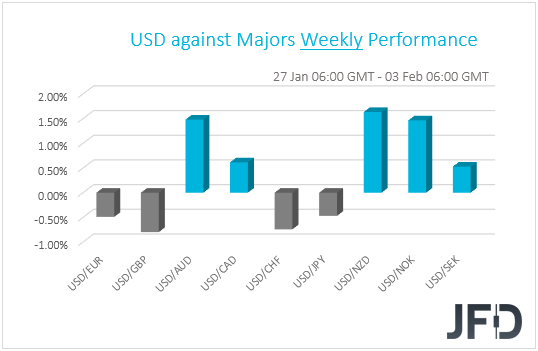
Investors returned with the same mood to their desks this week, with China’s Shanghai Composite tumbling 7.72% on its first trading day after the Lunar New Year Holidays, while Japan’s Nikkei 225 fell 1.01%. With the virus spreading at a fast pace, fears over its effects on economic activity continued to heighten. The number of deaths has surged to 361, with the first death out of China reported on Sunday in the Philippines. If undertaken measures to prevent the spreading prove not enough this week as well, the week could also be marked with defensive trading and investing.

On Tuesday, during the Asian morning, the RBA decides on interest rates. At its latest meeting, the Bank kept interest rates unchanged at 0.75%, but the statement accompanying the decision may have been less dovish than many may have expected. Officials said that they decided to hold rates steady given the long and variable lags in the transmission of monetary policy. Although they reiterated that they will continue to monitor developments, including in the labor market, and ease policy further if needed, the aforementioned addition suggests that they were more comfortable on the sidelines.
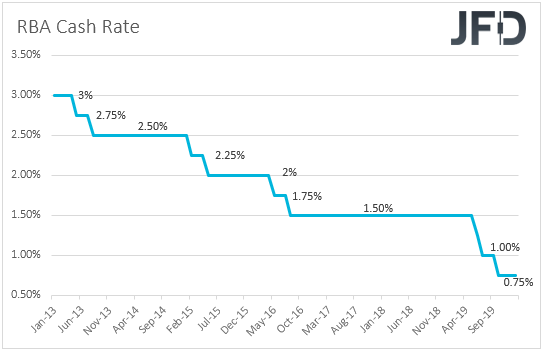
However, following the devastating bushfires, investors raised bets that the fires’ effects on the economy could force the RBA to hit the cut button as soon as at this gathering. That said, the better-than-expected employment and CPI prints for December and Q4 respectively prompted participants to push back those bets and, according to the ASX 30-day interbank cash rate implied yield curve, they are now fully pricing in a quarter-point rate reduction to be delivered in May.
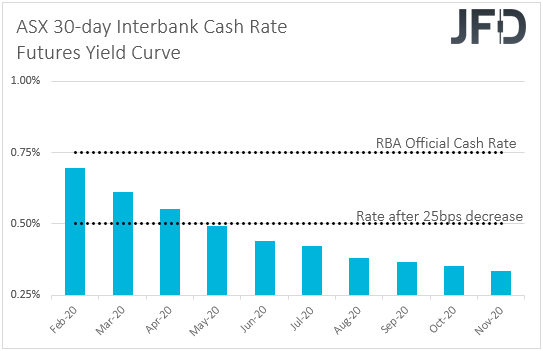
In our view, the RBA is unlikely to push the cut button at this meeting, but they may acknowledge downside risks from the bushfires, as well as the coronavirus. They could also highlight that, despite the improvement in inflation, it still stands below the lower end of their target range. We believe that all this may allow policymakers to reiterate their readiness to act if the outlook deteriorates further, and may also result downside revisions to their forecasts included in the Statement of Monetary Policy, which will be released on Friday.
As for Tuesday’s data, during the European day, we get Eurozone’s PPIs for December. The forecast suggests a small acceleration in monthly terms, to +0.3% from +0.2%, which will drive the yoy rate up to -0.7% from -1.4%. Later, from the US, we get factory orders for December, which are expected to have rebounded 1.2% mom after sliding 0.7% in November.
On Wednesday, during the early Asian morning, New Zealand’s employment report for Q4 is coming out. The unemployment rate is expected to have held steady at 4.2%, and the employment change to reveal an acceleration in added jobs, to +0.3% qoq from +0.2% in Q3. The labor cost index is expected to have slowed in quarterly terms, to +0.5% from +0.6%, but this would drive the yoy rate up to 2.4% from 2.3%.
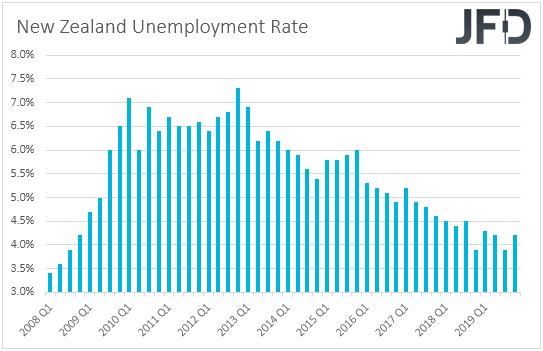
At its November meeting, the RBNZ surprised investors, who were largely pricing in a rate cut, and instead decided to stand pat, keeping its rates at +1.0%. That said, they maintain an easing bias, saying that they will add further monetary policy stimulus if needed. Back then they noted that employment remains around its maximum sustainable level and thus, combined with the acceleration in the nation’s CPI rate to 1.9%, just a tick below the Bank’s target range of 1-3%, further improvement in labor market conditions may allow policymakers to wait a bit longer before they decide whether to cut interest rates further, or not. Having said all that, the big risk to that view is the fast-spreading coronavirus which could have a negative impact on New Zealand’s economy. Let’s not forget that New Zealand is one of China’s main trading partners.
China’s Caixin services PMI for January is anticipated to have ticked up to 52.6 from 52.5. That said, bearing in mind that the official non-manufacturing print rose to 54.1 from 53.5, we see the risks surrounding the Caixin index as tilted somewhat to the upside.
In the EU morning, we get the final services and composite PMIs from the Eurozone and the UK. Again, the final prints are expected to confirm their preliminary estimates. Eurozone’s retail sales for December are also due to be released. The mom rate is expected to have declined to -0.5% from +1.0%, but this will push the yoy rate up to 2.5% from 2.2%.
In the US, the ADP employment report for January is due to be released. The report is anticipated to show that the private sector added 159k jobs, less than the 202k job gain in December. This may raise speculation that the NFP print, due out on Friday, may come very close to its forecast of 161k. However, bearing in mind that the correlation between the two time series has fallen in recent years, we believe that the ADP is far from a reliable predictor of the NFP number. Even last month, the ADP accelerated to 202k from 124k, but the NFPs slowed to 145k from 256k. Taking data from back in January 2011, the correlation of those time series (no revisions are taken into account) is now standing at 0.41. The ISM non-manufacturing PMI for January and the nation’s trade balance are also coming out. The ISM index is forecast to tick up to 55.1 from 55.0, while the trade balance is anticipated to show that the US deficit has widened to 48.00bn from 43.10bn.
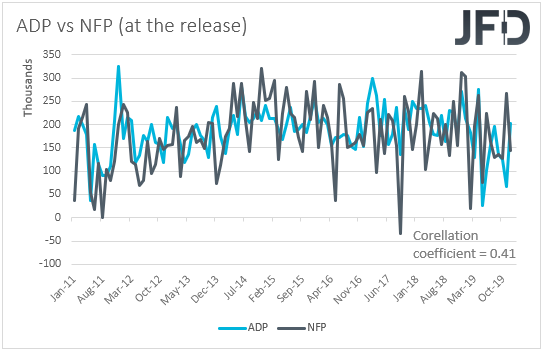
From Canada, we get the trade balance for December, with the nation’s deficit expected to have narrowed.
On Thursday, markets in New Zealand will be closed in celebration of the National Day. From Australia, we have trade and retail sales figures, both for December. The nation’s trade surplus is expected to have increased, while retail sales are anticipated to have declined 0.2% after rising 0.9% in November. However, this will push the qoq rate for Q4 up to 0.3% from -0.1%.
Finally, on Friday, the spotlight is likely to turn to the US employment report for January. Nonfarm payrolls are expected to have increased 161k, more than December’s 145k, while the unemployment rate is anticipated to have held steady at its 50-year low of 3.5%. Average hourly earnings are forecast to have accelerated to +0.3% mom from +0.1%, which barring any revisions to the prior monthly prints, may drive the yoy rate a tick higher, to +3.0% from 2.9%.
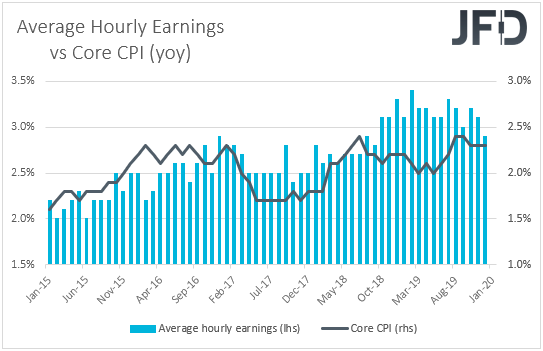
Overall, the numbers point to a very decent report, but we don’t expect it to vanish expectations with regards to another rate cut by the FOMC, especially if the ISM manufacturing PMI stays stuck in the contractionary territory for another month. The message we got from the latest FOMC meeting is that policymakers are not comfortable with inflation persistently under their 2% target, and with the core PCE rate staying below that objective since December 2018, they may start thinking about rate cuts again if this continues for more. Therefore, solid employment numbers could just encourage investors to push back the timing of when they expect the Fed to deliver another rate decrease. According to the Fed funds futures, such a move is fully priced in for July.

We get jobs data for January from Canada as well. The unemployment rate is expected to have ticked up to 5.7% from 5.6%, while the net change in employment is forecast to show that the economy added 20.5k jobs, less than the 35.2k in December. At its previous gathering, the BoC removed from the statement the part saying that it is appropriate to maintain the current level of interest rates, and instead noted that “In determining the future path for the Bank's policy interest rate, Governing Council will be watching closely to see if the recent slowdown in growth is more persistent than forecast”. This means that officials have opened the door to a rate cut, with Governor Poloz confirming that at the press conference following the decision. Thus, the aforementioned jobs forecasts suggest that the door for a potential decrease in the upcoming months is likely to stay open.
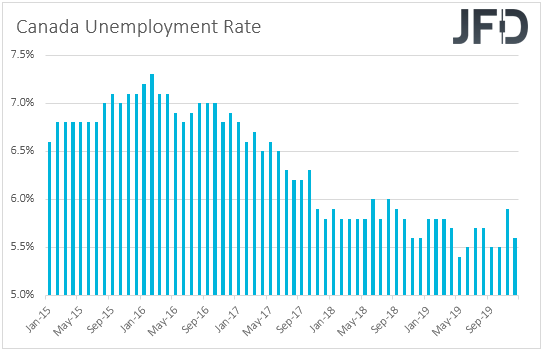
As for the rest of Friday’s events, during the Asian morning, China’s trade balance for January is coming out, though no forecast is currently available. Later, during the European session, we get Germany’s industrial production, trade and account balances, all for December. Norway’s GDP for Q4 is also due to be released, with the mainland print anticipated to reveal a slowdown to +0.3% qoq from +0.7% in Q3.
